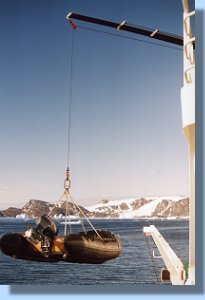
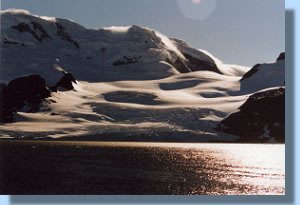
A glance through the window shows us a blue sky. We're anchored in Shingle Cove and the snow-covered landscape in front of us is bathing in the golden rays of the sun. Three glaciers elegantly 'flow' down from the mountains until they reach the sea, their calving resulting in several icebergs in the bay.
Altough it's 6.30 in the morning we're eager to go ashore. We can hardly wait until the zodiacs have been lifted into the waters of Shingle Cove. After a zodiac tour around some of the bay's icebergs we're ferried to a small pebbly beach.
A large group of Adélie penguins hesitates at the waterfront. They know that the first few meters are the most dangerous and they all wait for an courageous colleague to dive in first. After a few attempts where they all run forwards toward the water and as sudden run back again a group of several tens of Adélies simultaneously plunge into the crystal clear water. An elephant seal watches the scene without much attention.
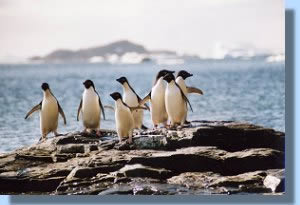
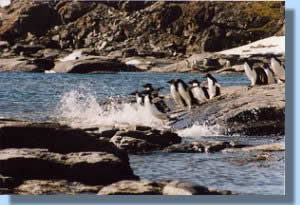
Returning penguins literally rocket out of the water sometimes toppling over when their forward velocity is too high for their feet to handle. Every now and then a returning Adélie surfaces close to one of us. It's funny to observe its confusion when it realizes that it hasn't returned amidst one of its black and white friends. We climb an icefield to reach the higher lying Adélie colony. Although it's smelly it isn't as bad as we expected it to be.
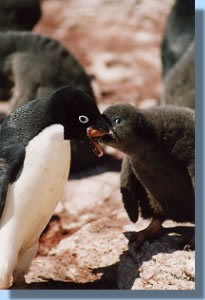
The colony is full of life. There are many chicks and most of the Adélie families have two young indicating an abundance of food. Frequently we're witnessing a food-chase where two chicks run after one of their parents to get some krill. In their chase other penguins that happen to be in the way are simply overrun and the chicks themselves also make some nice saltos when unexpected pieces of rock are met. The chase ends when the parent stops to regurgitate some krill for the quickest chick. And then the chase continues.
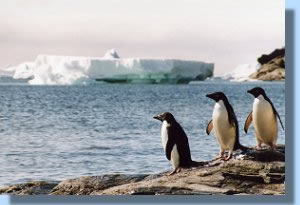
Other Adélie behavior is visible as well: courting between two Adélies with the accompanying sky-pointing, bickering when a certain Adélie is coming too close to one of its neighbors, the building of a nest by carefully arranging small pebbles on the rocky ground, pebble stealing from inattentive neighbors.
The weather remains excellent, the surroundings beautiful but time is ticking away. We're very sorry to leave when the last zodiac picks us up.
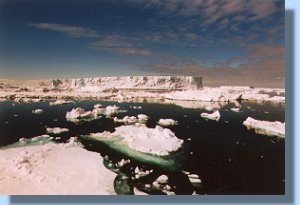
The next two hours we're sailing past impressive snow-covered landscapes with rugged peaks and many glaciers. The sea is filled with icebergs in almost every possible size and several times we have to plough our way through stretches with sea ice.
The damping of the waves because of all the ice in the water and the lack of wind regularly results in an unnaturally flat mirror like surface. When it's time for our excursion through the ship's interior we're almost reluctant to leave the bridge.
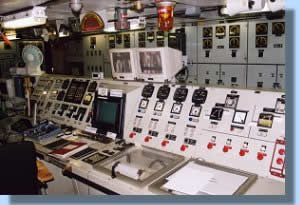
Our excursion starts in the control room. Some figures: The Polar Star is equipped with four independent 9-cylinder engines with 3400 h.p. each. Of the four engines, three can be switched to simultaneously drive one propeller. Every cylinder is roughly 50 cm in diameter.
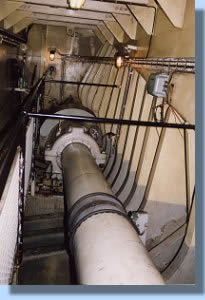
Our top speed is 19 knots but with two engines our cruising altitude is 14 knots. To be able to do some serious ice breaking, the hull of the Polar Star is 5 cm thick. And to be able to do some remote cruising the ship's able to produce some 50 cubic meters of fresh water a day (normal use is 22 cubic meters a day).
Then we descend even further into the ship's catacombs. We're on the lowest level now, the engine room itself. It's considerably cooler here. Both on our left and on our right side the two propeller shafts rotate bringing us closer to the Antarctic peninsula with every turn they make.
Back on deck the temperature has dropped, a wind is blowing an the spectacular scenery of only an hour ago has left. We see minke whales every now and then but still decide to remain inside for the rest of the evening.